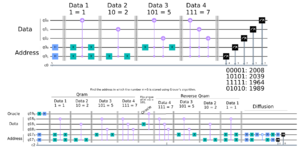QRAM: Difference between revisions
From wikiluntti
(→Theory) |
(→Theory) |
||
| Line 11: | Line 11: | ||
Data register <math>d</math> with <math>D_i</math> being the content of <math>i</math>th memory cell. QRAM is the operation <math>\sum_i \alpha_i |i\rangle_a \to \sum_i \alpha_i |i\rangle_a|D_i\rangle_d </math>. | Data register <math>d</math> with <math>D_i</math> being the content of <math>i</math>th memory cell. QRAM is the operation <math>\sum_i \alpha_i |i\rangle_a \to \sum_i \alpha_i |i\rangle_a|D_i\rangle_d </math>. | ||
=== Example === | |||
Store the data array <math>[1,2,5,7]=[1,10,101,111]_2</math> into a Qram addresses <math>[0, 1]_a</math>. | |||
Address register is <math>\sum_{i=0}^1 \alpha_i |i\rangle_a = \alpha_0 |0\rangle_a + \alpha_1 |1\rangle_a </math>. | |||
== References == | == References == | ||
https://arxiv.org/pdf/0708.1879.pdf | https://arxiv.org/pdf/0708.1879.pdf | ||
Revision as of 11:58, 29 November 2020
Introduction
Theory

The address and output registers of QRAM are composed of qubits instead of bits, though the memory array can be either quantum or classical.
Address register : superposition .
Data register with being the content of th memory cell. QRAM is the operation .
Example
Store the data array into a Qram addresses .
Address register is .






![{\displaystyle [1,2,5,7]=[1,10,101,111]_{2}}](https://wikimedia.org/api/rest_v1/media/math/render/svg/5c8de86f1d11d6e884dbdd21ea017468c302a28b)
![{\displaystyle [0,1]_{a}}](https://wikimedia.org/api/rest_v1/media/math/render/svg/ff9995dfe8342ca6d4e6c83e28dca5ec72c66cd0)
